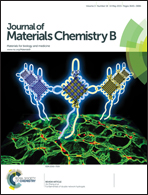Carbon functionalized metal organic framework/Nafion composites as novel electrode materials for ultrasensitive determination of dopamine
Abstract
Carbon functionalized metal organic frameworks (C/Al-MIL-53-(OH)2) were successfully prepared for the first time by a solvothermal technique and characterized by Fourier transform infrared spectroscopy, X-ray diffraction spectrometry, and scanning electron microscopy. This composite was coated with a Nafion film so as to form a Nafion/C/Al-MIL-53-(OH)2 modified glassy carbon electrode. The modified electrode was then used as a novel electrocatalyst for dopamine (DA) oxidation in phosphate buffer solution. Due to the synergistic effects of the different materials, including the high conductivity of carbon, the large surface area of Al-MIL-53-(OH)2, and the film-forming ability of a cation-exchange polymer, the modified electrode exhibited a remarkable enhancement effect on voltammetric response of DA. Under the optimal conditions, the response peak currents had a linear relationship with the DA concentration in the range from 3.0 × 10−8 to 1.0 × 10−5 mol L−1. The limits of detection and quantitation for DA were found to be 0.8 × 10−8 mol L−1 and 2.6 × 10−8 mol L−1, respectively. The analytical utilities of the proposed biosensor were achieved by analyzing the content of DA in biological fluids.


 Please wait while we load your content...
Please wait while we load your content...